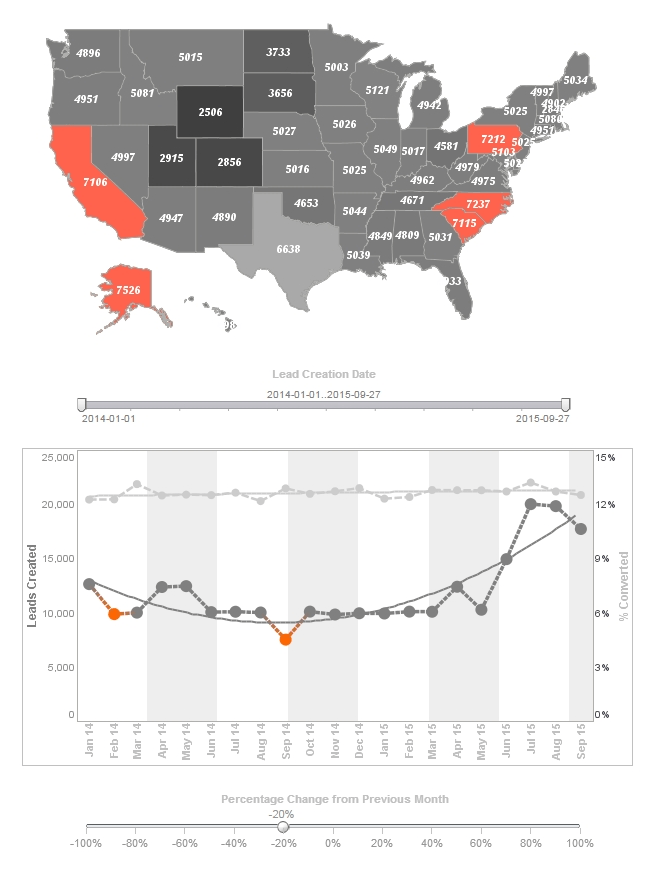What is the Process for Building a KPI Dashboard?
Below is a continuation of the transcript of a Webinar hosted by InetSoft on the topic of Best Practices for Key Performance Indicators. The presenter is Mark Flaherty, CMO at InetSoft.
Mark Flaherty (MF): You should start with a top-down approach, work with senior management to find out what they think the key performance indicators are. “Key” is important in order to come up with a finite number of truly important metrics. Eight to 10 is usually the right number. They should be chosen because they reflect “Performance,” and they are the ones that employees can affect with their actions and decisions.
Once you have those, that will germinate the development of deeper level KPIs at the operational and departmental levels. You can then break those measures out and rank them on a couple of criteria. First, which are the most important for getting the results they need to get? Second, you have to determine what is collectible. A lot of times companies start out having already a third of their desired KPIs being measured and monitored.
Then another third are sitting around here somewhere. They are in some operational databases that are not necessarily that easy to get to. But you can point your BI web reporting software at them, and you can get them. And then there is the final third, the data that you don’t collect, yet. So a big part of figuring out what measures you will settle on is determining which are the metrics that can be gotten that support the company’s goals and objectives.
Once you’ve done that identified that list of metrics, and you’ve got your performance management or KPI dashboard software installed, now you link up those metrics to scorecards and dashboards. Use the automated tools and ETL processes to get the data in databases if they are not already. A lot of times you might find that the second category of KPIs have been tracked in personal spreadsheets, so you’ll need some capability to get that data into the BI platform.
And you should get those KPI dashboards out the door first.

Case Study: Enhancing Obstetrics Practice with KPI Dashboards
Bloom Women's Health Clinic is a mid-sized obstetrics practice located in a bustling metropolitan area. The clinic offers a wide range of services, including prenatal care, labor and delivery, postpartum support, and gynecological services. Despite its excellent reputation, the clinic faced several challenges:
- Fragmented Data: Patient information, clinical metrics, and operational data were spread across multiple systems.
- Operational Inefficiencies: Scheduling, resource allocation, and patient flow management were suboptimal.
- Quality Assurance: Ensuring consistent quality of care and adherence to clinical guidelines was difficult without real-time monitoring.
To address these challenges, the clinic decided to implement KPI dashboards to centralize data, streamline operations, and monitor clinical performance.
Implementation
1. Identifying Key Performance Indicators (KPIs): The first step was to identify the most relevant KPIs for the obstetrics practice. The clinic focused on the following areas:
-
Clinical Outcomes:
- Maternal and neonatal mortality rates
- Rate of Cesarean sections vs. vaginal births
- Incidence of preterm births
- Patient satisfaction scores
-
Operational Efficiency:
- Average patient wait time
- Appointment no-show rate
- Bed occupancy rate
- Resource utilization (staff, equipment, rooms)
-
Financial Performance:
- Revenue per patient visit
- Billing and collections efficiency
- Insurance claim denial rate
2. Selecting the Right Tools: The clinic partnered with InetSoft, a leading provider of data mashup tools and business intelligence solutions. InetSoft's platform allowed the clinic to integrate data from various sources, including Electronic Health Records (EHR), patient management systems, and financial software.
3. Dashboard Development: A cross-functional team, including IT specialists, clinicians, and administrative staff, collaborated to design intuitive and interactive dashboards. The dashboards provided real-time visualizations of KPIs, enabling stakeholders to gain insights at a glance.
4. Training and Adoption: Staff training was crucial for the successful adoption of the KPI dashboards. Comprehensive training sessions were conducted to ensure that all users, from physicians to administrative staff, were comfortable using the new system.
Results
1. Improved Clinical Outcomes: With real-time monitoring of clinical KPIs, the clinic identified and addressed areas needing improvement. For example, by analyzing the Cesarean section rates, the clinic implemented targeted interventions to encourage vaginal births where safe and feasible, reducing unnecessary C-sections by 15% within six months.
2. Enhanced Operational Efficiency: The dashboards highlighted bottlenecks in patient flow and resource allocation. By optimizing appointment scheduling and improving patient communication, the clinic reduced average patient wait times by 20% and the appointment no-show rate by 12%.
3. Financial Health: Financial dashboards provided insights into revenue streams and billing processes. By identifying patterns in insurance claim denials, the clinic streamlined its billing practices, reducing the denial rate by 10% and increasing overall revenue by 8%.
4. Increased Patient Satisfaction: Patient satisfaction scores improved significantly as a result of enhanced clinical care and reduced wait times. The clinic introduced a feedback loop where patient satisfaction data was regularly reviewed and acted upon, fostering a culture of continuous improvement.
